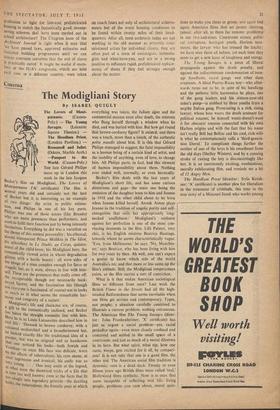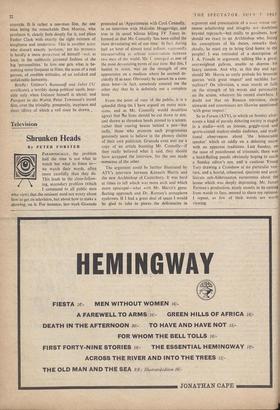Cinema
The Modigliani Story
By ISABEL QU1GLY The Lovers of Mont- parnasse. (Cameo- Poly.) — The Young Montparnasse ('A' certificate). T i The film s several years old and certainly not the best of Becker but it is interesting as an example Of two things: the artist in public estima- tor', and Philipe in one of his key parts. Philipe was one of those actors (like Brando) Who are more presences than performers, and seem to fulfil their function just by being intensely themselves. Everything he did Was a variation on the theme of this central personality: his ethereal, almost transparent Prince Mishkin in The Idiot, his schoolboy in Le Diable an Corps, quintes- sence of the child-lover, his Modigliani here, the romantically viewed artist in whom degradation glitters with a hectic beauty : all were sides of the image of a man complex enough for farce or tragedy but, as it were, always in line with him- self. These are the presences that really come off, the recognisable though not necessarily hack- neyed figures, and the fascination lies (though not everyone is fascinated, of course) not in looks so much as in what seems the remarkable har- mony and congruity of a nature. odiglis life and character are, of course, a gift to the romantically inclined, and Becker has taken the straight romantic line with him. Here he is as Louis Latourettes described him in real life: 'Dressed in brown corduroy, with a coloured neckerchief and a broadbrimrned hat, he looked exactly like the traditional idea of a Painter, but was so original and so handsome that one noticed his looks--both Jewish and Venetian atonce. His face was delicate, worn by the effects of tuberculosis; his eyes shone, at °nee ingenuous and ironical; his smile was so at young. .' One may smile at the legend, ?-1- what seem the theatrical tricks of a life that Is now too well known; even at the facts that fit t g,y oo sou_i into legendary grooves--the dazzling looks the tuberculosis, the frenetic pace at which everything was taken, the failure alive and the commercial success soon after death, the mistress who flung herself through a window when he died, and was buried with him. But how get round that brown-corduroy figure? It existed; and there was a touch, more than a touch, of the authentic poete :natal" about him. It is this that Gerard Philipe managed to suggest, the fatal impossibility as a human being of a certain kind of artist, and the inability of anything, even of love, to change him. All Philipe parts, in fact, had this element of human impossibility about them. Nothing ever ended well, normally, or even heroically.
Becker's film deals with the last years of Modigliani's short life, and has some curious distortions and gaps—the main one being the omission of the daughter born to him and Jeanne in 1918 and the other child about to be born when Jeanne killed herself. Anouk Aimee plays Jeanne in the tradition of angelic purity and self- abnegation that suits her appropriately long- necked soulfulness : Modigliani's outburst against her perfection is one of the most con- vincing moments in the film. Lilli Palmer, very chic, is his English mistress Beatrice Hastings, towards whom he seems characteristically vague. 'You, from Melbourne,' he says. 'No, Manches- ter,' says Beatrice, who has been living with him for two years by then. Ah well, you can't expect a genius to know which side of the world Australia's on; and that more or less sums up the film's attitude. Still, the Modigliani temperament exists, so the film carries a sort of conviction.
What is it that makes American sociological films so different from ours? Last week the British Flame in the Streets had all the high- minded flatfootedness that seems inevitable when our films get serious and contemporary. Types, not people; a situation carefully contrived to illustrate a current problem; nothing extraneous. The American film The Young Savages (direc- tor: John Frankenheimer; 'X' certificate) has just as urgent a social problem—yes, racial prejudice again--even more closely confined and contrived and settled in the small space of a courtroom, and just as much of a moral dilemma in its hero. But what spirit, what zip; how one cares, weeps, gets excited for it all, by compari- son! It is not only that one is a good film, the other not. The American social film tradition is dynamic; ours is a dead duck. Twenty or even fifteen years ago British films were called 'real,' Hollywood films synthetic. Now it is ours that seem incapable of reflecting real life, living people, problems you care about, moral ques- tions to make you cheer or groan; and again and again American films that set people cheering (about, after all, to them far remoter problems) in our two-and-nines. Courtroom scenes, cal corruption, hooligan youth, Harlem tene- ments, the lawyer who has crossed the tracks; we have seen them all before, yet each time they seem to get a new lease of toughness and energy.
The Young Savages is a piece of liberal propaganda against the death penalty, and against the indiscriminate condemnation of teen- age hoodlums. racial gangs and other slum eruptions. A blind Puerto Rican boy—who after- wards turns out to be, in spite of his handicap and the pathetic little harmonica he plays, one of the gang leaders and his sixteen-year-old sister's pimp—is stabbed by three youths from a nearby Italian gang. Prosecuting is a rich, rising lawyer, whose boss wants the death sentence for political reasons; he himself wants-doesn't-want it for obscurer reasons connected with his own Harlem origins and with the fact that his name isn't really Bell but Bellini and his cool, rich wife is what he contemptuously calls a 'third-genera- tion liberal.' To complicate things further the mother of one of the boys is his sweetheart from the old days (Shelley Winters), and by a cunning stroke of casting the boy is disconcertingly like her. It is an enormously exciting, rumbustious, morally exhilarating film, and reminds me a bit of 12 Angry Men.
The Hoodlum Priest (director: Irvin Kersh- ner; 'A' certificate) is another plea for liberalism in the treatment of criminals, this time in the true story of a Missouri Jesuit who works among convicts. It is rather a one-man film, the one man being the remarkable Don Murray, who produces it, clearly feels deeply for it, and plays Father Clark with exactly the right mixture of toughness and tenderness. This is another actor who doesn't exactl lorm,' yet his presence is hardly a mere proiection of himself—not, at least, in the ruthlessly personal fashion of the big 'personalities.' In him one gets what is be- coming more frequent in films, the sense of a real person, of credible attitudes, of an unfaked and unfakeable humanity.
Briefly: Ustinov's Romanofl and Juliet ('U' certificate), a terribly damp political squib, bear- able only when Ustinov himself is about; and Passport to the WON, Peter Townsend's travel film, over the triviality. pomposity, ineptness and sheer idiocy of which a veil must be drawn.. .



























































 Previous page
Previous page